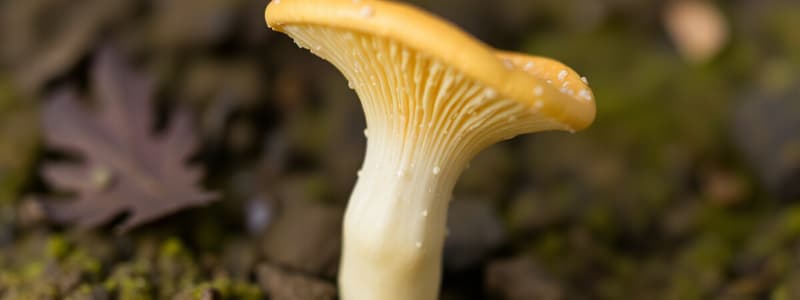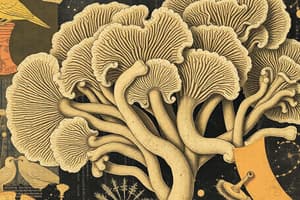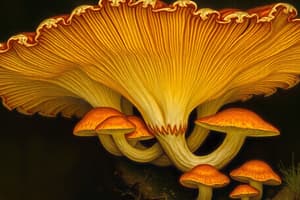Podcast
Questions and Answers
Which characteristic is not typical of most fungi?
Which characteristic is not typical of most fungi?
- Multicellular eukaryotic structure
- Autotrophic nutrition (correct)
- Nutrition through heterotrophic absorption
- Cell walls made of chitin
Saprophytes obtain nutrients from living hosts.
Saprophytes obtain nutrients from living hosts.
False (B)
What is the main structural difference between septate and coenocytic hyphae?
What is the main structural difference between septate and coenocytic hyphae?
Septate hyphae have cell walls dividing them into cells, while coenocytic hyphae lack these divisions.
The collective network of hyphae is called a ______.
The collective network of hyphae is called a ______.
Match the type of mycorrhizae with its description:
Match the type of mycorrhizae with its description:
What is the primary role of haustoria in fungi?
What is the primary role of haustoria in fungi?
Plasmogamy is the fusion of nuclei from two different mycelia.
Plasmogamy is the fusion of nuclei from two different mycelia.
Define 'heterokaryon' in the context of fungal reproduction.
Define 'heterokaryon' in the context of fungal reproduction.
The fusion of nuclei in fungi is known as ______.
The fusion of nuclei in fungi is known as ______.
Match the term with its correct definition in fungal reproduction:
Match the term with its correct definition in fungal reproduction:
Which of the following is a method of asexual reproduction in fungi?
Which of the following is a method of asexual reproduction in fungi?
Fungi are capable of performing photosynthesis.
Fungi are capable of performing photosynthesis.
What environmental condition favors the growth of molds on fruits and bread?
What environmental condition favors the growth of molds on fruits and bread?
Asexual fungi commonly reproduce through the release of haploid ______.
Asexual fungi commonly reproduce through the release of haploid ______.
Match the fungal phylum with its unique characteristic:
Match the fungal phylum with its unique characteristic:
Which fungal phylum includes species known to 'aim' their sporangia toward light?
Which fungal phylum includes species known to 'aim' their sporangia toward light?
Glomeromycetes form arbuscular mycorrhizae with plant roots, penetrating the plant cell walls.
Glomeromycetes form arbuscular mycorrhizae with plant roots, penetrating the plant cell walls.
What is the ecological significance of glomeromycetes?
What is the ecological significance of glomeromycetes?
Ascomycota, also known as ______ fungi, produce spores in a sac-like structure.
Ascomycota, also known as ______ fungi, produce spores in a sac-like structure.
Match the fungal structure with its function:
Match the fungal structure with its function:
Which of the following is a structure associated with Basidiomycota?
Which of the following is a structure associated with Basidiomycota?
Basidiocarps are the asexual reproductive structures of club fungi.
Basidiocarps are the asexual reproductive structures of club fungi.
Describe the function of a basidium in Basidiomycota.
Describe the function of a basidium in Basidiomycota.
A basidiocarp is commonly known as a ______.
A basidiocarp is commonly known as a ______.
Associate each role with the respective fungi.
Associate each role with the respective fungi.
Which of the following is a plant disease caused by fungi?
Which of the following is a plant disease caused by fungi?
Ringworm is a fungal infection that affects plants.
Ringworm is a fungal infection that affects plants.
Name two examples of fungi used in food production.
Name two examples of fungi used in food production.
Ergot of rye, caused by Claviceps purpurea, produces compounds that can cause ______ and twitching.
Ergot of rye, caused by Claviceps purpurea, produces compounds that can cause ______ and twitching.
Match the term related to Ergot with its significance.
Match the term related to Ergot with its significance.
Flashcards
Fungi: Cell Type
Fungi: Cell Type
Multicellular eukaryotes (except yeasts).
Fungi: Nutrition
Fungi: Nutrition
Fungi are heterotrophs that obtain nutrients via absorption.
Saprophytes
Saprophytes
Fungi that live on dead matter.
Parasites (fungi)
Parasites (fungi)
Signup and view all the flashcards
Mycelium
Mycelium
Signup and view all the flashcards
Hyphae
Hyphae
Signup and view all the flashcards
Septate Hyphae
Septate Hyphae
Signup and view all the flashcards
Coenocytic Hyphae
Coenocytic Hyphae
Signup and view all the flashcards
Haustoria
Haustoria
Signup and view all the flashcards
Mycorrhizae
Mycorrhizae
Signup and view all the flashcards
Ectomycorrhizal Fungi
Ectomycorrhizal Fungi
Signup and view all the flashcards
Arbuscular Mycorrhizal Fungi
Arbuscular Mycorrhizal Fungi
Signup and view all the flashcards
Plasmogamy
Plasmogamy
Signup and view all the flashcards
Karyogamy
Karyogamy
Signup and view all the flashcards
Asexual Fungi Reproduction
Asexual Fungi Reproduction
Signup and view all the flashcards
Fungi as Mold
Fungi as Mold
Signup and view all the flashcards
Yeasts
Yeasts
Signup and view all the flashcards
Chytrids
Chytrids
Signup and view all the flashcards
Zygomycota
Zygomycota
Signup and view all the flashcards
Glomeromycota
Glomeromycota
Signup and view all the flashcards
Ectomycorrhizal fungi
Ectomycorrhizal fungi
Signup and view all the flashcards
Arbuscular
Arbuscular
Signup and view all the flashcards
Ascomycota
Ascomycota
Signup and view all the flashcards
Ascus
Ascus
Signup and view all the flashcards
Basidiomycota
Basidiomycota
Signup and view all the flashcards
Basidium
Basidium
Signup and view all the flashcards
Basidiocarps
Basidiocarps
Signup and view all the flashcards
Lichens
Lichens
Signup and view all the flashcards
Roles of Fungi
Roles of Fungi
Signup and view all the flashcards
Claviceps Purprea
Claviceps Purprea
Signup and view all the flashcards
Study Notes
- Chapter 31 is about Fungi.
Characteristics of Fungi
- Fungi are multicellular eukaryotes with the exception of yeasts
- Fungi obtain nutrition as heterotrophs through absorption
- Fungi secrete enzymes to break down food molecules outside their cells, then absorb the nutrients across their cell walls
- Saprophytes live on dead organic matter
- Parasites benefit at the expense of a host
- Mutualistic relationships benefit both the host and the fungi
- Hyphae are filaments which constitute the structure of fungi, these cell walls are made of chitin
- Mycelium is the network of hyphae
- Septate hyphae are divided into cells by septa (walls)
- Aseptate hyphae are multinucleate, long tubes described as coenocytic with continuous cytoplasmic mass
Specialized Hyphae
- Haustoria are nutrient-absorbing hyphae found in both parasitic and mutualistic fungi, and penetrate the cell walls of hosts to extract nutrients
- Some fungi have modified hyphae, such as hoops, to penetrate and digest living animals
- Mycorrhizae are a specialized type of hyphae.
- Ectomycorrhizal fungi form sheaths of hyphae over the root and in extracellular spaces
- Arbuscular (endomycorrhizal) fungi branch hyphae through the root cell walls, forming tubes through which they penetrate the root plasma membrane
Growth and Reproduction
- Most fungal hyphae are haploid
- Fungi exhibit both sexual and asexual reproduction, releasing spores that are haploid and unicellular
- Fungal reproduction does not include a flagellated stage
- Fusion of cytoplasm and nuclei occur at different times during sexual reproduction
- Plasmogamy is the fusion of cytoplasm from two mycelia
- In plasmogamy, the nuclei do not fuse, resulting in a heterokaryon (different nuclei)
- Karyogamy is the fusion of nuclei that creates a zygote
- Meiosis follows karyogamy, producing spores that grow into hyphae, which are (n)
Reproduction
- Many fungi can reproduce asexually
- Mold sometimes grows on fruit, bread and other foods and grows haploid spores
- Other asexual fungi are yeasts
- Yeasts inhabit moist environments
- Yeasts reproduce via simple cell division or budding off
Fungal Phylogeny
- Chytridiomycota (chytrids) have motile spores with flagella and 1,000 species
- Zygomycota have resistant zygosporangium as a sexual stage and 1,000 species
- Glomeromycota form arbuscular mycorrhizae and have 160 species
- Ascomycota (sac fungi) bear sexual spores internally in sacs called asci and contains 65,000 species
- Basidiomycota (club fungi) have elaborate fruiting bodies called basidiocarps and contains 30,000 species
Phylum Chytridiomycota (Chytrids)
- Chytrids have flagellated spores
- Chytrids play a role in amphibian population decline
- Chytrids attack the keratin layer and 'suffocates' frogs
Phylum Zygomycota
- Zygomycota are zygote fungi-they are molds that cause food to rot
- Zygomycota have coenocytic hyphae with asexual spores
- Zygomycota form a zygospore
- An example of Zygomycota is Rhizopus sp.(bread mold)
- Some zygomycetes, like Pilobolus, "aim" their sporangia toward bright light
Phylum Glomeromycota
- Glomeromycota were once considered zygomycetes, but are now a separate clade
- Glomeromycota are mycorrhizae, associating with plant root hairs
- Ninety-percent of plants have mutualistic partnerships with glomeromycetes
- Glomeromycota increase plant productivity by delivering phosphate and nutrients to plant roots
- Glomeromycota allow plants to supply carbohydrates.
Phylum Ascomycota
- Ascomycota are sac fungi
- Ascomycota contain ascus
- Ascus produces sexual spores in a sac
- Fruiting bodies of fungi are ascocarp's
- Example of phylum ascomycota is orange peel fungus
- Phylum Ascomycota includes single-celled yeasts
- Phylum Ascomycota includes lichen associations
- Phylum Ascomycota includes truffles and morels
Phylum Basidiomycota
- Basidiomycota are club fungi
- Members of Basidiomycota include mushrooms, shelf fungi, and puffballs
- Members of Basidiomycota have clublike structures called basidium
- Clublike structures of members of Basidiomycota result in a transient diploid stage in the life cycle
- In members of Basidiomycota, basidium means 'pedestal'
- Members of Basidiomycota have basidocarps-fruiting bodies that are mushrooms
- Basidiomycota's includes wood decomposers
- Basidiomycota's includes common mushrooms
- Basidiomycota's undergo “fairy rings” i.e. life cycle includes a long-lived dikaryotic mycelium, and its fruiting structure, a mushroom, that can built in just a few hours.
Roles of Fungi
- Fungi aid in digestion of plant material of grazing mammals
- Fungi are 'farmed' by ants and termites
- Penicillium is a mold that is in the antibiotic family
- Truffles, morels, chanterelles, blue cheese, alcohol, and bread are food products that are products of fungi
- Fungi can cause disease
- Fungi can cause blight in plants
- Fungi can cause ringworm in humans
- Cryptococus gattii is a deadly basidiomyctes fungus found on Vancouver Island
- Cryptococus gattii causes disease
Claviceps Purpurea (Ergot)
- A type of ascomycetes
- Cool, wet years result in higher rates of ergot infection
- Ingestion of Ergot lowers immunity
- Black plague hit harder in areas where rye bread that was ingested was contaminated with ergot
- Ergot ingestion leads to miscarriages and lower fertility
- Ergot ingestion leads to hallucination and twitching
- All of the above negative effects of ergot were blamed on witches
- Ergot is used to treat migraines, stimulate labour, and is a source of LSD
Lichens
- A symbiotic relationship of millions of photosynthetic microorganisms, cyanobacteria or green algae.
- The Fungal component of Lichen is most often an ascomycete
- Algae or cyanobacteria occupy an inner layer below the lichen surface
Studying That Suits You
Use AI to generate personalized quizzes and flashcards to suit your learning preferences.




